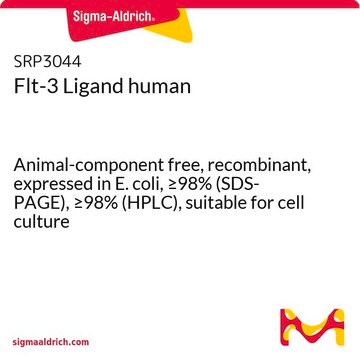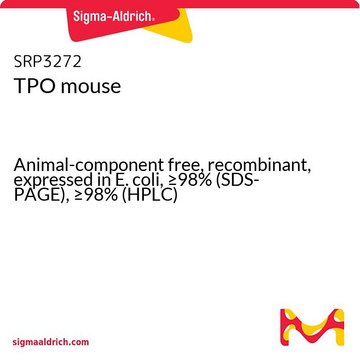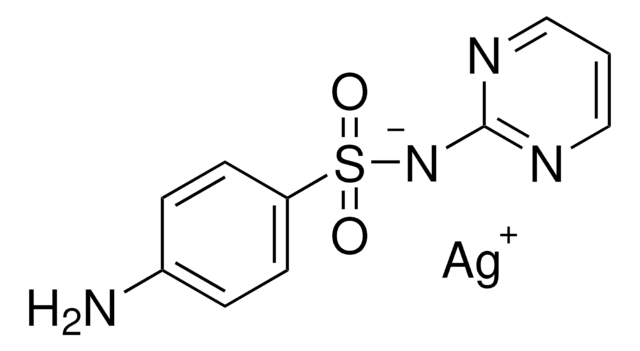T4184
Thrombopoietin from mouse
recombinant, expressed in NSO cells, lyophilized powder, suitable for cell culture, >97% (SDS-PAGE)
Synonim(y):
TPO
Zaloguj sięWyświetlanie cen organizacyjnych i kontraktowych
About This Item
Polecane produkty
pochodzenie biologiczne
mouse
Poziom jakości
rekombinowane
expressed in NSO cells
Próba
>97% (SDS-PAGE)
Formularz
lyophilized powder
siła działania
2.1 ng/mL EC50
masa cząsteczkowa
~75 kDa by SDS-PAGE (as a result of glycosylation)
predicted mol wt 35 kDa
opakowanie
pkg of 5 μg
warunki przechowywania
avoid repeated freeze/thaw cycles
metody
cell culture | mammalian: suitable
zanieczyszczenia
endotoxin, tested
numer dostępu UniProt
temp. przechowywania
−20°C
informacje o genach
mouse ... Thpo(21832)
Zastosowanie
Trombopoetyna pochodząca od myszy może być stosowana w genetycznym teście przesiewowym do badania roli somatycznych mutacji aktywujących w genach EPOR, MPL lub GCSFR w aktywacji zaburzeń mieloproliferacyjnych (MPD) u pacjentów z MPD JAK2V617F-ujemnych.
Działania biochem./fizjol.
Trombopoetyna pochodząca od myszy jest peptydem aminokwasowym, który odgrywa kluczową rolę w proliferacji i różnicowaniu megakariocytów. Służy również jako czynnik wzrostu dla komórek śródbłonka wątroby u myszy.
TPO is a ligand for the c-mpl proto-oncogene (Mpl-L), a megakaryocyte colony stimulating factor (Meg-CSF), and a primary regulatory factor for megakaryocytopoiesis and thrombopoiesis. TPO is a humoral glycoprotein that stimulates growth and maturation of megakaryocytes and megakaryocytic colonies from bone marrow cultures. TPO binds and activates a 68-78 kDa glycoprotein receptor belonging to the GH family of cytokine receptors, a family that includes receptors to growth hormone (GH), erythropoietin (EPO) and prolactin (PRL). TPO receptors are found on megakaryocytes and their precursors and on platelets. The mature form of TPO is a highly conserved, showing approximately 70% sequence homology among various mammals.
Thrombopoeitin (TPO), also known as the ligand for the c-mpl proto-oncogene (Mpl-L) and as megakaryocyte colony stimulating factor (Meg-CSF), is a primary regulatory factor for megakaryocytopoiesis and thrombopoiesis. Produced mainly by hepatocytes but also by kidney cells, TPO is a humoral glycoprotein that stimulates growth and maturation of megakaryocytes and megakaryocytic colonies from bone marrow cultures. TPO binds and activates an 68-78 kDa glycoprotein receptor belonging to the GH family of cytokine receptors, a family that includes receptors to growth hormone (GH), erythropoietin (EPO) and prolactin (PRL). Like GH and EPO, TPO may bind to its receptor at two distinct sites, initiating receptor dimerization and activation. Analysis of mRNA indicates also the existence of a novel truncated and potentially soluble form of TPO receptor. The viral oncogene v-mlp of the myeloproliferative leukemia virus (MPLV) contains the gene sequence for the entire cytoplasmic and transmembrane domains and a portion of the extracellular domain of c-mlp (TPO receptor). TPO receptors are found on megakaryocytes and their precursors and on platelets. The mature form of TPO is a highly conserved glycoprotein, showing approximately 70% sequence homology among various mammals. Human TPO contains 332 amino acids (mouse 335) including two internal disulfide bonds and 6 N-linked glycosylation sites (mouse 7). The N-terminal 153 amino acid region of TPO shows structural and amino acid sequence homology to erythropoietin and a pair of arginines (potential cleavage site) separating it from the highly glycosylated carboxyterminal domain.
Postać fizyczna
Lyophilized from a 0.2 μm filtered solution in phosphate buffered saline containing 0.25 mg bovine serum albumin
Komentarz do analizy
The biological activity was measured in a cell proliferation assay using MO7e cells.
Ta strona może zawierać tekst przetłumaczony maszynowo.
Kod klasy składowania
11 - Combustible Solids
Klasa zagrożenia wodnego (WGK)
WGK 3
Temperatura zapłonu (°F)
Not applicable
Temperatura zapłonu (°C)
Not applicable
Środki ochrony indywidualnej
Eyeshields, Gloves, type N95 (US)
Wybierz jedną z najnowszych wersji:
Masz już ten produkt?
Dokumenty związane z niedawno zakupionymi produktami zostały zamieszczone w Bibliotece dokumentów.
J E Cardier et al.
Blood, 91(3), 923-929 (1998-02-03)
Present data suggest that the primary site of thrombopoietin (TPO) mRNA is the liver. Previously, we reported that specific murine liver endothelial cells (LEC-1) located in the hepatic sinusoids support in vitro megakaryocytopoiesis from murine hematopoietic stem cells suggesting that
P Rojnuckarin et al.
Blood, 94(4), 1273-1282 (1999-08-10)
Thrombopoietin (TPO) plays a critical role in megakaryocyte proliferation and differentiation. Using various cultured cell lines, several recent studies have implicated the mitogen-activated protein kinase (MAPK) pathway in megakaryocyte differentiation. In the study reported here, we examined the role played
Shun-Mei Lu et al.
Brain, behavior, and immunity, 44, 221-234 (2014-12-03)
Neuro-inflammation plays a key role in the occurrence and development of postoperative cognitive dysfunction (POCD). Although S100A8 and Toll-like receptor 4 (TLR4) have been increasingly recognized to contribute to neuro-inflammation, little is known about the interaction between S100A8 and TLR4/MyD88
Yana Pikman et al.
PLoS medicine, 3(7), e270-e270 (2006-07-13)
The JAK2V617F allele has recently been identified in patients with polycythemia vera (PV), essential thrombocytosis (ET), and myelofibrosis with myeloid metaplasia (MF). Subsequent analysis has shown that constitutive activation of the JAK-STAT signal transduction pathway is an important pathogenetic event
L M Privette Vinnedge et al.
Oncogene, 34(18), 2325-2336 (2014-06-24)
Disease progression and recurrence are major barriers to survival for breast cancer patients. Understanding the etiology of recurrent or metastatic breast cancer and underlying mechanisms is critical for the development of new treatments and improved survival. Here, we report that
Nasz zespół naukowców ma doświadczenie we wszystkich obszarach badań, w tym w naukach przyrodniczych, materiałoznawstwie, syntezie chemicznej, chromatografii, analityce i wielu innych dziedzinach.
Skontaktuj się z zespołem ds. pomocy technicznej








